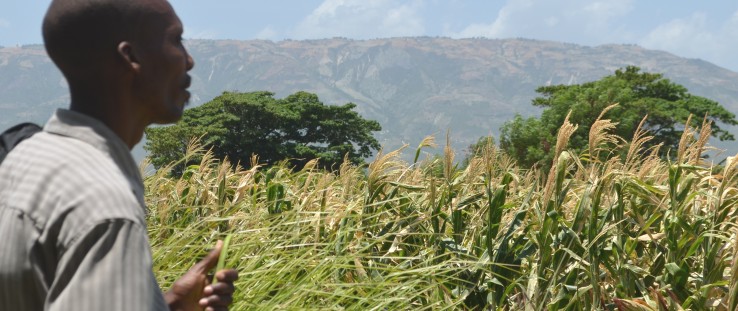 Master farmer Auguste Jean-Emmanuel looks out over the corn fields at the Rural Center for Sustainable Development in Bas-Boen.
Nena Terrell, USAID
Master farmer Auguste Jean-Emmanuel looks out over the corn fields at the Rural Center for Sustainable Development in Bas-Boen.
Nena Terrell, USAID
 Master farmer Auguste Jean-Emmanuel looks out over the corn fields at the Rural Center for Sustainable Development in Bas-Boen.
Nena Terrell, USAID
Master farmer Auguste Jean-Emmanuel looks out over the corn fields at the Rural Center for Sustainable Development in Bas-Boen.
Nena Terrell, USAID
Parched fields, scorched under the relentless Caribbean sun and starved for summer rains, are overtaking the rural landscape in Haiti. For some farmers, the situation is dire.
“We look up to the sky, but the rain doesn’t come,” Pepe Marie Veronne, a corn farmer from the lower plains, laments.
Without access to modern farming techniques or machinery, let alone science-based climate and weather data, farmers’ livelihoods hinge precariously on a changing environment that they’re struggling to understand.
Rainfall is erratic—flooding farms in the north while crops wilt and die in Haiti’s fertile plains, all in the same year. Temperatures are rising, and precious topsoil blows away in the winds. Nearly 60 percent of employed Haitians work in agriculture, so in 2009, Feed the Future—the U.S. Government’s global hunger and food security initiative—teamed up with the Ministry of Agriculture to launch a project designed to help farmers adapt to climate change.
The result: a modern research lab called the Rural Center for Sustainable Development (CRDD), fully equipped with facilities for soil and water analysis, onsite farming demonstrations and classrooms, industrial farming equipment and even dormitories for farmers who travel long distances. The lab is run by mostly Haitian staff and a team of student interns from Haiti’s national schools of engineering and chemistry.
The lab’s motto is that sustainable agriculture—the cornerstone of climate-resilient farming—is about understanding your environment and farming smarter. In rural areas of Haiti, people often look to the supernatural to explain the challenges they face; staff at the lab encourage them to look to science.
Agronomist Kenel Cadet, who runs the CRDD for the Haitian Foundation for Sustainable Agricultural Development (FONHDAD), explains that last year, 80 percent of local bean farmers lost crops from pest infestations, an issue related to rising temperatures. “A farmer told me it was God’s will. Farmers need to know they can prevent such losses and how.”
Farmers who train at the CRDD specialize in livestock, grain or vegetable production—but only after completing a crash course in climate change. Their curriculum covers conservation agriculture, environmental management, techniques of fertilization and sustainable development—with additional content tailored to farmers’ specific challenges.
The lab is the first of its kind in Haiti and, according to Cadet, it’s essential for overcoming challenges associated with climate change. As he puts it, teaching sustainable farming starts at the beginning: in the dirt.
“Understanding the type of soil you have is crucial for making smart decisions about what to grow, how to fertilize, and how to deal with water shortages,” he explains.
To demonstrate the utility of soil analysis, CRDD staff, working with the Ministry of Agriculture and the U.S. Department of Agriculture, one of 11 U.S. agencies that make up Feed the Future, conducted a pilot project studying over 3,000 hectares of soil. The researchers identified 10 unique soil types in the Cul-de-Sac plain, a low-lying region surrounding Port-au-Prince, finding very low levels of organic matter (less than 2 percent) and pH irregularities. Armed with this information, the value of soil analysis is unmistakable to researchers, policymakers and the farmers themselves, who see benefits in their growing fields and incomes.
Auguste Jean Emmanuel, who farms okra, explains: “In the past, we used to burn the organic material left over from harvest, but now we don’t do that. Now, we know to compost so we don’t waste anything and our soil is strong.”
Saint-Juste Jean Wesly, a bean farmer, uses the soil analysis on his own farm to customize a balance of nitrogen, phosphorous and potassium needed to create an optimal growing environment for his crop.
“Before the training program, I would only get 50 to 75 pounds of beans from one 5-pound bag of seeds. Now I harvest 100 to 125 pounds,” he said.
Using the same plot of land, Jean Wesly’s income is double what he was earning before graduating from the master farmer training program at the CRDD, and he’s not alone. Farmers using techniques taught at the center report an average 120 percent increase in their incomes. They’re also conserving valuable resources by calibrating the use of fertilizer to exactly what’s needed on their farms.
Since the CRDD and its network of satellite centers opened their doors in 2011, over 3,000 farmers have finished the month-long program, and in exchange have set up demonstration plots in their own communities to share what they’ve learned with other farmers. Today, they’ve reached nearly 4,000 additional farmers.
“I meet with farmers in my area practically every day. I have so much to share and the people in my community are so eager for new techniques,” says Veronne, the corn farmer from the lower plains who is also a master farmer.
Veronne runs a demonstration farm in her community. Before planting anything, she tills the soil and lets it rest so essential microbes can get to work. Later, she’ll build neat rows of raised beds and collect soil samples, digging down 10 centimeters first. Over the next few days, she’ll germinate a sample of seeds to determine their health and will use the soil analysis results to mix her fertilizer. If at least 80 percent of her seeds germinate, it’s time to plant.
The ditches she digs between her beds ensure enough water reaches her plants, without wasting a drop on seeds that have no chance of survival. By switching from the traditional practice of growing corn in a flooded square patch of land to growing corn on raised beds, farmers are planting 400 percent more seedlings per hectare, using the same amount of water needed for traditional planting methods.
“I’m saving seeds and water, and my corn grows stronger than ever,” says Veronne.
Each drop of water is critical in Haiti. Halfway through the rainy season this year, only one quarter of expected rain has fallen. As Haiti rounds year two of extreme drought, the CRDD and Ministry of Agriculture are in a race against climate change to identify new sources of water and to install irrigation systems needed to pump life back into withering crops. To further help farmers adapt, a new Feed the Future Haiti project is working to study alternate sources of groundwater and to promote the use of climate data to help inform farmers about when to adjust planting time and when to switch crops.
So far, the farmers in the Cul-de-Sac region are hanging on. Despite the challenges of the drought, farmer Charlotin Jean-Baptiste says, “We’re well-trained and we have the will to support our communities. Help from the CRDD has been a huge step forward for us.”







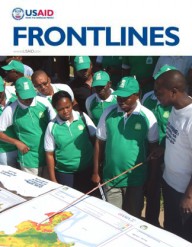

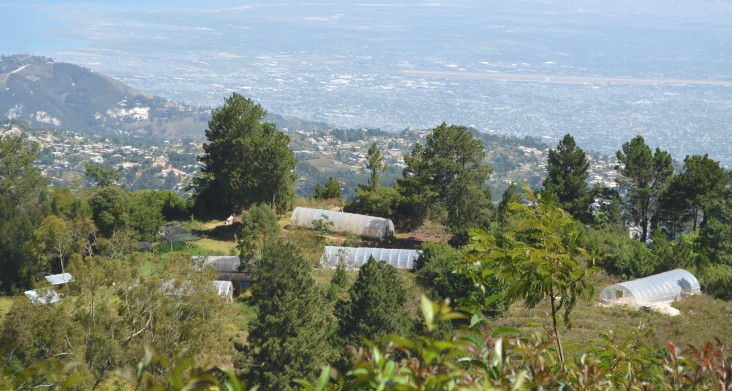
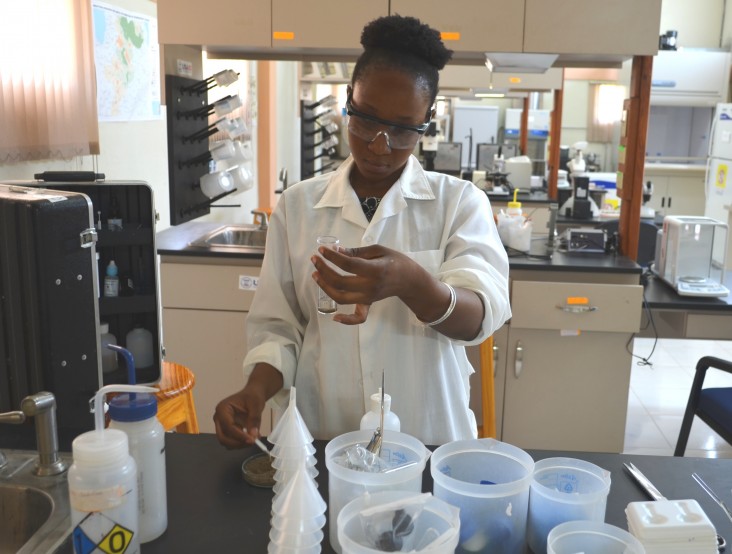
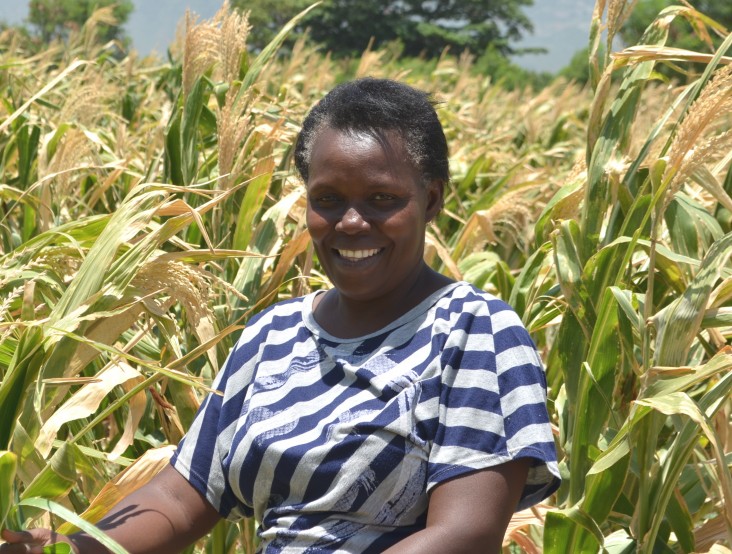

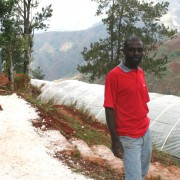

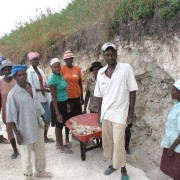
Comment
Make a general inquiry or suggest an improvement.